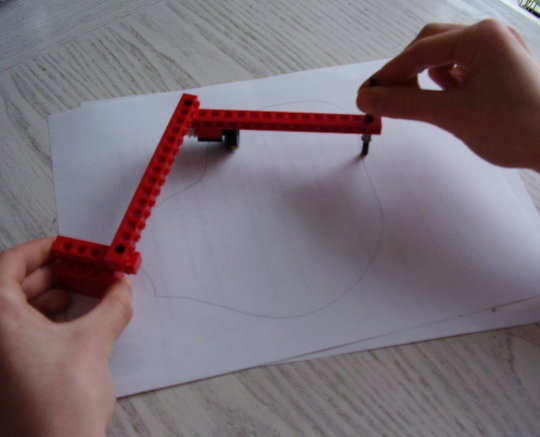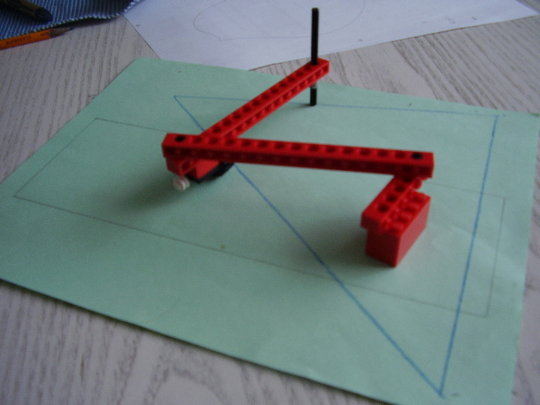0708-1300/Class notes for Tuesday, November 27: Difference between revisions
No edit summary |
m (→First Hour) |
||
| Line 85: | Line 85: | ||
'''Real Plane''' |
'''Real Plane''' |
||
Consider <math>\Omega^0(\mathbb{R}^ |
Consider <math>\Omega^0(\mathbb{R}^2)\rightarrow^d\Omega^1(\mathbb{R}^2)\rightarrow^d\Omega^2(\mathbb{R}^2)</math> |
||
Forms in <math>\Omega^1(\mathbb{R}^ |
Forms in <math>\Omega^1(\mathbb{R}^2)</math> look like <math>Fdx +Gdy</math> and map under d to <math>(G_x - F_y)dx\wedge dy</math> |
||
Hence applying Stokes' Theorem: |
Hence applying Stokes' Theorem: |
||
| Line 97: | Line 97: | ||
In complex analysis we also have a similar result Cauchy's Theorem where the integral of an analytic function around a closed path is zero. This is because analytic functions obey the Cauchy-Riemann equations and hence <math>G_x-F_y</math> is identically zero. |
In complex analysis we also have a similar result Cauchy's Theorem where the integral of an analytic function around a closed path is zero. This is because analytic functions obey the Cauchy-Riemann equations and hence <math>G_x-F_y</math> is identically zero. |
||
===Second Hour=== |
===Second Hour=== |
||
Revision as of 17:02, 8 February 2008
| ||||||||||||||||||||||||||||||||||||||||||||||||||||||||||||||||||||||||||||||||||||||||||||||||||||||||||||
Today's Agenda
- The planimeter with a picture from http://whistleralley.com/planimeter/planimeter.htm but our very own plane geometry and Stokes' theorem.
- Completion of the proof of Stokes' theorem.
- Completion of the discussion of the two- and three-dimensional cases of Stokes' theorem.
- With luck, a discussion of de-Rham cohomology, homotopy invariance and Poincaré's lemma.
Class Notes
The notes below are by the students and for the students. Hopefully they are useful, but they come with no guarantee of any kind.
First Hour
Planimeter
A planimeter consists of two rods connected with a join where the end of one rod is fixed (but free to rotate) and the opposing end of the second rod traces out the boundary of some surface on the plane. I.e., the planimeter is kind of like a 1 legged roach. At the join of the two rods is a wheel which rotates (and measures the rotation) when the rod tracing the boundary moves in the normal direction and simply slides back an forth when moved in a tangential direction.
Now we recall from plane geometry that we can locate points in the polar form and have the equations and
Hence,
Hence
Now, the planimeter is essentially a 1 form corresponding to the speed of the wheel. We consider a diagram where the angle from the horizontal at the fixed end of the planimeter to the measuring end is and the angle from the horizontal to the first rod (the one connected to the fixed point) is . Hence and
With a little plane geometry we can see that
Computing,
Now applying stokes theorem, the the planimeter integrates over the boundary of our surface and hence this is just the integral of over the surface. But this is just the integral of the area form.
Hence the planimeter measure the area of a surface.
Back to Stokes Theorem
Firstly recall that is oriented so that if you prepend the outward normal to its orientation you get the orientation of M
Alternatively we recall that neighborhoods of points on the boundary look like the half space. Hence we can choose to restrict our attention to atlas's where all charts look like
We can see that these orientations are the same, i.e., just prepend the outward normal to the half space.
Proof of Stokes
We have now defined all the terms. WLOG is supported in one chart (by linearity)
For a compactly supported n-1 form on H need to show that
We let (where the hat means it is omitted)
So,
via fundamental theorem of calculus and that the f_i's are compactly supported we get
Hence with the standard inclusion of we get
Thus these are the same and the theorem is proved Q.E.D.
Real Plane
Consider
Forms in look like and map under d to
Hence applying Stokes' Theorem:
This is known as Greens Theorem
In complex analysis we also have a similar result Cauchy's Theorem where the integral of an analytic function around a closed path is zero. This is because analytic functions obey the Cauchy-Riemann equations and hence is identically zero.
Second Hour
Example 2
Recall previous we had consider the spaces and showed that and corresponded with functions and that and corresponded with triples of functions (i.e. vector fields). We also showed that the d function between these spaces was the gradient, curl and divergence functions from vector calculus.
We are now interested in integrating, using Stokes Theorem, forms in these spaces.
First, note that to a 0 manifold, assigning an orientation to the manifold is just assigning a plus or minus sign to the manifold as a result of it having a trivial basis.
This is consistent with 0 manifolds being the boundary of 1 manifolds. Indeed,
Now consider a path
Now lets compute
First,
Likewise for each component of we thus get
where is the vector of coefficients of
Now we know that is a vector perpendicular to v and w with magnitude equal to the area of the defined parallelogram. So,
where denotes the normal vector and is the area form and is a surface
Now for ,
now,
and
This is Gauss' Divergence Theorem.
We can think about this as saying that the flow from each point in a domain, when summed up, will be just the flow out of the boundary of the domain.
We also get Stokes' Theorem:
End of Example
We recall that since , if then . But is the converse true? The following Lemma says 'yes', if the domain is
Poincare's Lemma
On iff such that
This is NOT true for general M, as our homework assignment showed since we had a form that had but was not d of a form.
Likewise, on we have
Claim:
For appropriate but no such that
This is in our next homework assignment.
Now, if there was such a ,
If (such as any sphere)
But,
Definition
Clearly so the following definition makes sense:
Definition (de-Rham Cohomology)
Claim
yet .
Also,
More fun with the planimeter
You can build your own low-tech planimeter out of lego!
Here my left hand is holding the fixed point steady while the right hand traces the shape. The net number of times the wheel turns while the shape is traced out indicates the area.
The empirical test: the two shapes below have the same area, and while tracing them the wheel turned almost exactly the same number of times (about 2.3 rotations). Moreover, tracing smaller shapes caused it to turn fewer times, larger shapes more.
The problem: I couldn't do better than this. Calibrating it (calculating how many rotations corresponds to exactly what area) was a nightmare. Mathematically it was possible, but my planimeter is not accurate enough to agree with my math. If you wish to build your own more accurate one, you might want to try using a thinner wheel or one that grips the table better so you don't accidently lose any turning motion.




















![{\displaystyle \int _{H}d\omega =\sum \int _{[x_{1}\leq 0]}(-1)^{i-1}{\frac {\partial f_{i}}{\partial x_{i}}}dx_{1}\wedge \cdots \wedge dx_{n}=\sum (-1)^{i-1}\int _{[x_{1}\leq 0]}{\frac {\partial f_{i}}{\partial x_{i}}}}](https://wikimedia.org/api/rest_v1/media/math/render/svg/48995ea624ce6c9141feab7af9233089deef59e0)
![{\displaystyle =\int _{[x_{1}\leq 0]}{\frac {\partial f_{1}}{\partial x_{1}}}=\int _{[x_{1}=0]}f_{1}}](https://wikimedia.org/api/rest_v1/media/math/render/svg/052e34fd037c6b73cdd96cc5b52ed61ce292b82a)

![{\displaystyle \int _{\partial H}\omega =\int _{\mathbb {R} _{x_{2}\cdots x_{n}}^{n-1}}\iota ^{*}(\sum f_{i}dx_{1}\wedge \cdots \wedge {\hat {dx_{i}}}\wedge \cdots \wedge dx_{n})=\int _{[x_{1}=0]}f_{1}}](https://wikimedia.org/api/rest_v1/media/math/render/svg/7c9fc2f942fe02949b4abb54987268377c541526)












![{\displaystyle \gamma :[0,1]\rightarrow \mathbb {R} ^{3}}](https://wikimedia.org/api/rest_v1/media/math/render/svg/f571fb855af7f0a45d001b9e9f758d85fe339573)
![{\displaystyle \int _{\gamma }\omega _{1}=\int _{[0,1]}\gamma ^{*}\omega _{1}=\int _{[0,1]}\sum f_{i}d\gamma ^{*}(x_{i})=\int _{[0,1]}\sum f_{i}d\gamma _{i}}](https://wikimedia.org/api/rest_v1/media/math/render/svg/a3056c04142f3f77df10051f1bb19c25a24fc975)
![{\displaystyle =\int _{[0,1]}\sum f_{i}{\dot {\gamma }}_{i}dt=\int _{\gamma }{\vec {F}}\cdot {\vec {T}}_{\gamma }}](https://wikimedia.org/api/rest_v1/media/math/render/svg/7f77b2f759b798662b6b2d97f21607635e4533aa)








































